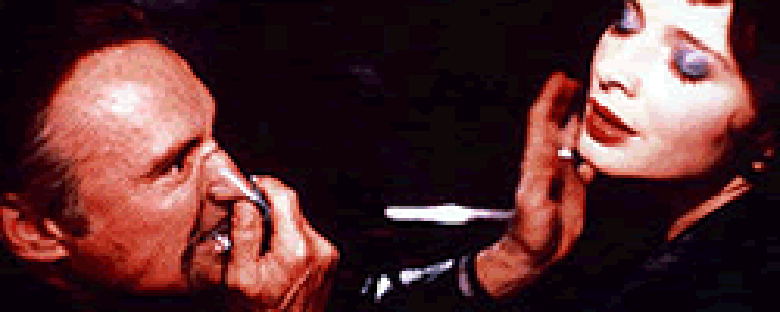Reviews
The sexual revolution in film came some ten years after the label’s coinage in the late Sixties. It began, roughly, with Last Tango in Paris. Directed by the acclaimed Bernardo Bertolucci, Last Tango is notorious for a sex scene involving Marlon Brando as an aging American expatriate and roughly a third of a stick of butter.
Theretofore sex in film could potentially be used as a means of revealing otherwise indeterminable character traits: primarily, vulnerability, instinct, and impulse. In Last Tango, Paul (Brando in a legendary performance) is somewhat of a passive observer, patiently allowing events to happen without his interruption. During sex he becomes more active, as it is a tool he uses to reduce the memory of his deceased wife.
The lurid eroticism of Last Tango in Paris is approached in a frank manner, as it is integral to the story and its characters. This is perhaps why many critics have mentioned it in reviews of Blue Velvet. It approaches sex in a similarly frank manner, though the end result is incomparably more affronting. If sex in film is a taboo that can be broken, then David Lynch’s Blue Velvet serves as one of the most harrowing attempt to destroy it.
Early on the film’s dangerously inquisitive protagonist, the aptly named Jeffery, suspects a local lounge singer of association in a crime and hides in her apartment in an amateurish plot to spy on her. She discovers him, procures a large knife, and forces him to strip. She proceeds to fondle him, insisting that she not be looked at. A knock on the door interrupts them, and Jeffery is sent back to the closet. Enter Frank Booth. He inhales a gas (helium?) from a portable tank on his belt and then rapes her, to a certain degree mirroring the very act of violence she performed on Jeffery. Frank exits, and moments later Jeffery consoles her, and she whispers to him: “Hit me.” In this brief twenty minutes, sexual roles are deliberately confused, reinvented, and ultimately reversed.
Even some fifteen years after the release of Blue Velvet its vision remains wildly adamant relative to the stride of other works of contemporary noir. There have been many films about suburban crime, but none as dangerously imposing as this.
What makes Blue Velvet increasingly disturbing is how it builds on and subsequently deconstructs audience expectations. The film’s setting and mood are introduced in an exposition lifted directly from older films (there are numerous references to It’s A Wonderful Life). In result the film is initially expected to follow a particular path. The film slowly plunges into crime and our expectations are violated by images of disquieting violence and sex, and suburban archetypes are paired with primal curiosity and perversion.
The film is set in Lumberton. This does not represent a quaint, small town by similarity; it is one. Lumberton is filled with characters that are completely typical. Presumably the cops eat doughnuts and the quarterback dates the head cheerleader not out of coincidence but of intention. These characters function to punctuate the story, not to distinguish it.
The famous individuality of Lynch’s vision is established in the darker side of Lumberton, one that is made known through the eyes of Jeffery, our detached observer. Important plot points are not figuratively underlined by clear dialogue and dim-witted, loudmouthed crooks. The film’s crime occurs incidentally, and the main characters discover it by second-hand.
Our perspective throughout the film is fixed on Jeffery, and is deliberately biased by his good nature. Jeffery is portrayed with great subtlety by Kyle MacLachlan whom Lynch aficionados will remember as the quirky FBI agent from Twin Peaks. He is paired with Sandy (Laura Dern), the daughter of a neighborhood investigator. Laura Dern epitomizes the “girl-next-door”; in Blue Velvet it is her literal function. Completing this diverse list of roles is a haunting and brief performance by Dean Stockwell, who, in an odd exchange (fitting, really, given the nature of the film) mimes an impromptu rendition of Roy Orbison’s “In Dreams.”
In the center of the slowly fashioned web of crime is Frank. Dennis Hopper’s performance as Frank Booth has been cited numerously as one of the most vile characters in cinema. His dialogue appropriately echoes his nature; he speaks, and acts, in brief, concentrated violent spurts, whether he is driving or demanding one of his thugs to fetch him a Pabst Blue Ribbon — his beer of choice.
Hitchcock was famous for his cinematic mistreatment of women (the ratio of men to women killed in his films would evidence this) and he is outdone only by Mr. Lynch. Though this is no laudable achievement, he is one of the few directors worthy of even a singular comparison to the master of suspense. In Eraserhead a mother births a limbless, monster-like child; Patricia Arquette is forced to strip at gunpoint to a roomful of men with mouths agape in Lost Highway. But no female at the whim of Lynch’s camera suffers more than Isabella Rossellini as Dorothy, the lounge singer in Blue Velvet. It is highly ironic, being that she was his wife at the time of filming. There have been sacrifices for one’s art, but seldom as controversial and known as this.
Blue Velvet is not a film that is easily appreciated. Likewise, it is not a film that is easily forgotten. It is a timeless controversy, and it is a vision demanding attention if not praise. Reviews for this film have employed staple descriptions, using words such as “shocking,” “controversial,” or “lurid,” (all of which, incidentally, are unavoidably used in this column). Seldom are these terms, though justified, so grossly inadequate.
We don’t do comments anymore, but you may contact us here or find us on Twitter or Facebook.



